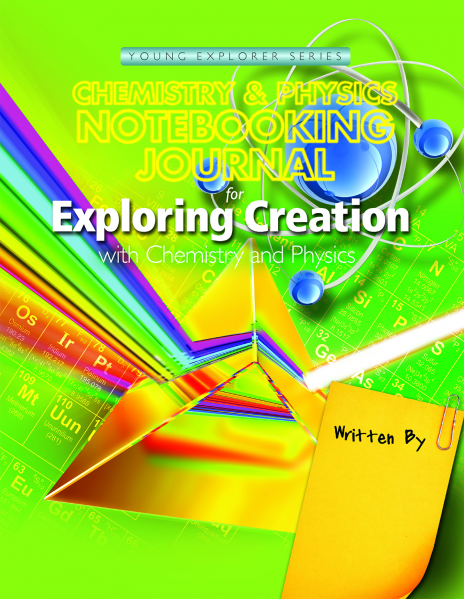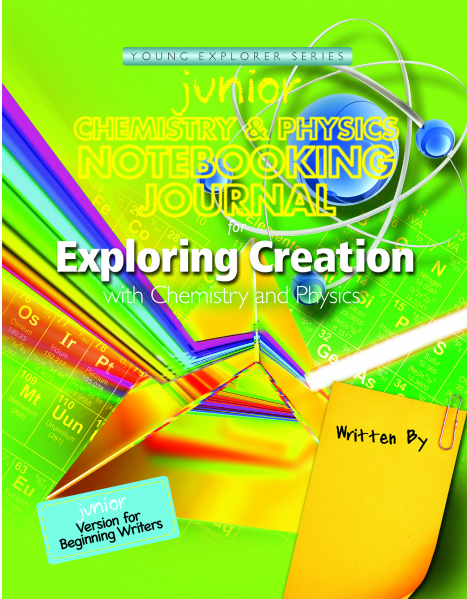Homeschool Science Made Fun and Easy!
Apologia Educational Ministries is a well known name in homeschool circles. They are especially known for their amazing hands-on science curriculums, which we have been blessed to use in our homeschool.
This fall, we were given the privilege to review Exploring Creation With Chemistry and Physics, the newest textbook set in the K-6th grade Apologia series. We also received the Exploring Creation with Chemistry and Physics Notebooking Journal for Melissa to review, and the Exploring Creation with Chemistry and Physics Junior Notebooking Journal for Kelly to review.
About this book: Exploring Creation with Chemistry and Physics is a large 280 page hardcover textbook with 14 chapters covering the following topics:
- Introduction to Chemistry and Physics
- Moving Matter (Properties of matter)
- Building Blocks of Creation (atoms, elements)
- Compound Chemistry (crystals, acids, reactants)
- Multitude of Mixtures (solutes, colloids, alloys)
- Mechanics in Motion (Newtons' Laws of Motion, inertia)
- Dynamics of Motion (friction, adhesion, gravity, centripetal force)
- Work In the World (types of energy)
- Sound of Energy (conductors, frequency, bioacoustics)
- Light of the World (spectrum, sources of light)
- Thermal Energy (thermodynamics)
- Electrifying Our World (electricity)
- Mysterious Magnetism
- Simple Machines (planes, levers, pulleys)
 We set aside our current Science studies, and completely focused on this Chemistry & Physics material for the last 5 weeks. In the book, there is a plan that we loosely followed, to complete each chapter (or lesson) in about 2 weeks. We started right at the beginning, and completed Lessons 1 and 2. I wanted to get the most out of this material for review purposes, so we did every experiment in the book! (There are plenty to choose from to illustrate the concepts - you don't have to do all of them, and can choose which ones are most appropriate for your children).
We set aside our current Science studies, and completely focused on this Chemistry & Physics material for the last 5 weeks. In the book, there is a plan that we loosely followed, to complete each chapter (or lesson) in about 2 weeks. We started right at the beginning, and completed Lessons 1 and 2. I wanted to get the most out of this material for review purposes, so we did every experiment in the book! (There are plenty to choose from to illustrate the concepts - you don't have to do all of them, and can choose which ones are most appropriate for your children).Since Melissa is a 7th grader, I wanted to make sure that she is really working this material inside out and soaking up all she can out of it. Not only are there a good number of activities in the book, and the notebooking journal, but there is also an "extras" website available, that has more information to be incorporated into your studies for students who wish to 'delve deeper' or parents who would like more information on explaining the reasoning behind why some of the experiments worked out the way they did.
 The way the textbook is set up, both my 3rd grader and 7th grader were able to use the book. We did the lessons together, and then each wrote notes in their respective journals. The regular notebook journal has much more room to record observations about experiments and notes from the textbook lessons. It also has a page of review questions, an intense vocabulary crossword puzzle, and extra mini-book projects (similar to what you might find in a lapbook). The only thing that Melissa thought was 'too young' for her was the copywork pages. (A page with a Scripture verse to copy that is applicable to the lesson).
The way the textbook is set up, both my 3rd grader and 7th grader were able to use the book. We did the lessons together, and then each wrote notes in their respective journals. The regular notebook journal has much more room to record observations about experiments and notes from the textbook lessons. It also has a page of review questions, an intense vocabulary crossword puzzle, and extra mini-book projects (similar to what you might find in a lapbook). The only thing that Melissa thought was 'too young' for her was the copywork pages. (A page with a Scripture verse to copy that is applicable to the lesson).The junior notebooking journal contained coloring pages, (which Kelly loved), a simpler crossword puzzle (which made her feel important - she had a 'harder thing', just like Melissa!), and pages to record her notes and observations about the textbook lesson and the experiments. She also had a mini book project, as well as copywork. (Which she is more used to doing, so it was not a problem for her).
The program is set up to do science lessons 3 days a week. We did it 3-4 days a week. We found that we had more time to complete all the experiments that way. It was also easier to break up the notebooking journal into smaller assignments over more days.
What we studied:
Here is a sampling of some of the topics we covered in the first two chapters:
We made four varied concentrations of salt water, illustrated by four different colors. We were able to layer them in a clear straw, according to their density levels.
Using salt water again, we were able to float an egg (and a bunch of other household items!) in salt water but not in tap water. We also layered a number of household liquids in a glass bottle, and dropped items into the bottle to see how far they would drop. This was probably the favorite experiment! The entire household was gathered around, guessing which layer the various items would end up, and cheering when they were right!Trapping air in a cup while dipping the cup underwater never gets old! The kids did it over and over again. I loved the idea of wadding up a piece of paper to fit into the bottom of the cup, to prove that no water was getting inside the cup!
Exploring surface tension by floating a needle on top of the water, and learning cohesion of water molecules by running them around a piece of wax paper!
When learning about the properties of matter, we created a gas by combining pop rocks and carbonated soda. We also built tin foil rafts to learn the best way to displace weight over the surface of the water. The girls' rafts held about 2oz of coins, but Mom's raft held 6.2 oz of coins!!!
Another fun project that received lots of "oohs and aahs" was creating an amorphous solid (it's matter that has the properties of both a solid and a liquid!) The girls 'studied' their pan of goo for about an hour before Mom made them clean it up! It was rather fascinating to feel a liquid that didn't splatter!
My highlights: I love the thoroughness of this text. It is written in simple enough language that a child can understand, yet has enough 'deeper' information that an older elementary (or in this case, junior high) student can really sink their teeth into it as well. There are enough activities and experiments to make it a complete study, although each chapter also has extra resources suggested to round out further studies. We did end up utilizing some of those as well (library books and videos).
My best endorsement of this book has to do with the strong Creation foundation that is given, right from page one. I love how matter is introduced by discussing Creation. The teaching completely aligns with the worldview that I am striving to teach my children.
I am also amazed at how much of this science the girls have understood. It is said that you completely understand something when you can explain it. They have been able to 'narrate' or explain back the concepts they have learned, and by doing all the hands-on experiments, they have been able to understand how those concepts relate to real life, further solidifying it in their minds. They have never retained so much material on this subject matter as they have after completing the first two lessons of this book!
What do the kids say? The success of this book can best be summed up with this one liner from Melissa, "Mom, this science is SO FUN!"
How much does this cost? The hardcover textbook is $39 and the notebooking journal and junior notebooking journal both sell for $24 each.
What grades are covered? This book is intended for K through 6th grade. As you can see from our example, we are successfully using it in 7th grade. It is intended for use with multiple grade levels at once in a homeschool situation.
I wholeheartedly recommend this homeschool science curriculum! See what other members of The Old Schoolhouse Review Crew thought of it, and how they are using it by clicking the banner below....












No comments:
Post a Comment
Thanks for sharing your thoughts!